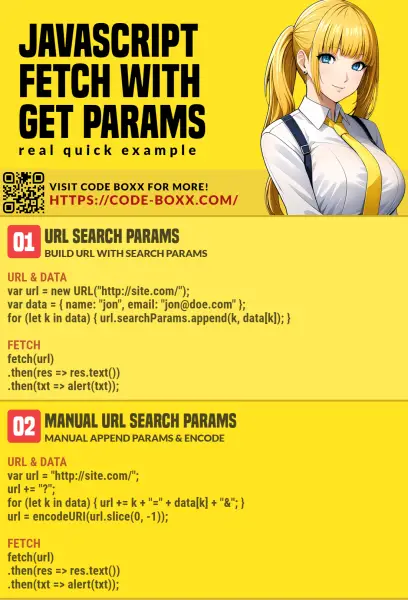Welcome to a tutorial and example on how to send a Javascript fetch request with GET query parameters. New to the fetch API, and trying to pass in some query parameters?
To send GET query parameters with Javascript fetch, simply create a new URL object and append the search parameters:
var data = { "KEY" : "VALUE" };var url = new URL("http://site.com/API");for (let k in data) { url.searchParams.append(k, data[k]); }fetch(url);
That covers the quick basics, but read on for detailed examples.
TLDR – QUICK SLIDES
[web_stories_embed url=”https://code-boxx.com/web-stories/send-get-params-with-javascript-fetch/” title=”Send GET Params With Javascript Fetch” poster=”https://code-boxx.com/wp-content/uploads/2021/11/STORY-JS-20230518.webp” width=”360″ height=”600″ align=”center”]
Fullscreen Mode – Click Here
TABLE OF CONTENTS
JAVASCRIPT FETCH WITH GET PARAMS
All right, let us now get into the examples of Javascript fetch with GET parameters.
EXAMPLE 1) APPEND SEARCH PARAMS
<script>
function fetchGet () {
// (A) DATA TO SEND
var data = {
name : "jon doe",
email : "jon@doe.com"
};
// (B) BUILD URL
var url = new URL("http://site.com/0-dummy.php");
for (let k in data) { url.searchParams.append(k, data[k]); }
console.log(url);
// (C) FETCH WITH GET SEARCH PARAMS
fetch(url)
// (D) RETURN SERVER RESPONSE AS TEXT
.then(res => {
console.log(res);
if (res.status != 200) { throw new Error("Bad Server Response"); }
return res.text();
})
.then(res => console.log(res))
// (E) HANDLE ERRORS (OPTIONAL)
.catch(err => console.error(err));
}
</script>
<input type="button" value="Fetch Get" onclick="fetchGet()">This is the “full version” of the introduction snippet. As you can see, the parameters are attached to the URL itself, it has nothing much to do with fetch(). Take note of how we generate the URL though:
var url = new URL();url.searchParams.append(KEY, VALUE);
The URL search params API is well-supported in all modern browsers at the time of writing, but take note that it will not work on the old Internet Exploders (caniuse.com).
EXAMPLE 2) MANUAL URL ENCODE
<script>
function fetchGet () {
// (A) DATA TO SEND
var data = {
name : "jon doe",
email : "jon@doe.com"
};
// (B) MANUAL CONSTRUCT URL & PARAMS
var url = "http://site.com/0-dummy.php";
url += "?";
for (let k in data) { url += k + "=" + data[k] + "&"; }
url = encodeURI(url.slice(0, -1));
// (C) FETCH WITH GET SEARCH PARAMS
fetch(url)
// (D) RETURN SERVER RESPONSE AS TEXT
.then(res => {
console.log(res);
if (res.status != 200) { throw new Error("Bad Server Response"); }
return res.text();
})
.then(res => console.log(response))
// (E) HANDLE ERRORS (OPTIONAL)
.catch(err => console.error(err));
}
</script>
<input type="button" value="Fetch Get" onclick="fetchGet()">If you have to support older browsers, the only way is to manually construct the URL string and parameters.
- Simply append the parameters behind the URL –
http://site.com/path?KEY=VALUE&KEY=VALUE - Then encode the URL using
encodeURI().
DOWNLOAD & NOTES
Here is the download link to the example code, so you don’t have to copy-paste everything.
SORRY FOR THE ADS...
But someone has to pay the bills, and sponsors are paying for it. I insist on not turning Code Boxx into a "paid scripts" business, and I don't "block people with Adblock". Every little bit of support helps.
Buy Me A Coffee Code Boxx eBooks
EXAMPLE CODE DOWNLOAD
Click here for the source code on GitHub gist, just click on “download zip” or do a git clone. I have released it under the MIT license, so feel free to build on top of it or use it in your own project.
EXTRA BITS & LINKS
That’s all for the tutorial, and here is a small section on some extras and links that may be useful to you.
COMPATIBILITY CHECKS
- Arrow Functions – CanIUse
- Fetch API – CanIUse
- URL Search Params – CanIUse
The examples will work on all modern browsers. Old Internet Exploders, beware.
LINKS & REFERENCES
- Fetch API – MDN
- POST Form Data With Fetch – Code Boxx
INFOGRAPHIC CHEAT SHEET

THE END
Thank you for reading, and we have come to the end. I hope that it has helped you to better understand, and if you want to share anything with this guide, please feel free to comment below. Good luck and happy coding!
